In 2017, I spent a week in a Christian community on Iona, an island in the Scottish Inner-Hebrides. This is a description of my journey to the Island. It’s an all day trip from Edinburgh, where I’d stayed with friends. I had hope to lead a group to Iona afterwards, but the next summer, the Abbey was closed for renovation. In 2019, it was only partly open, then along came COVID! This is an edited post that I am migrating over from another blog.
Leaving Edinburgh
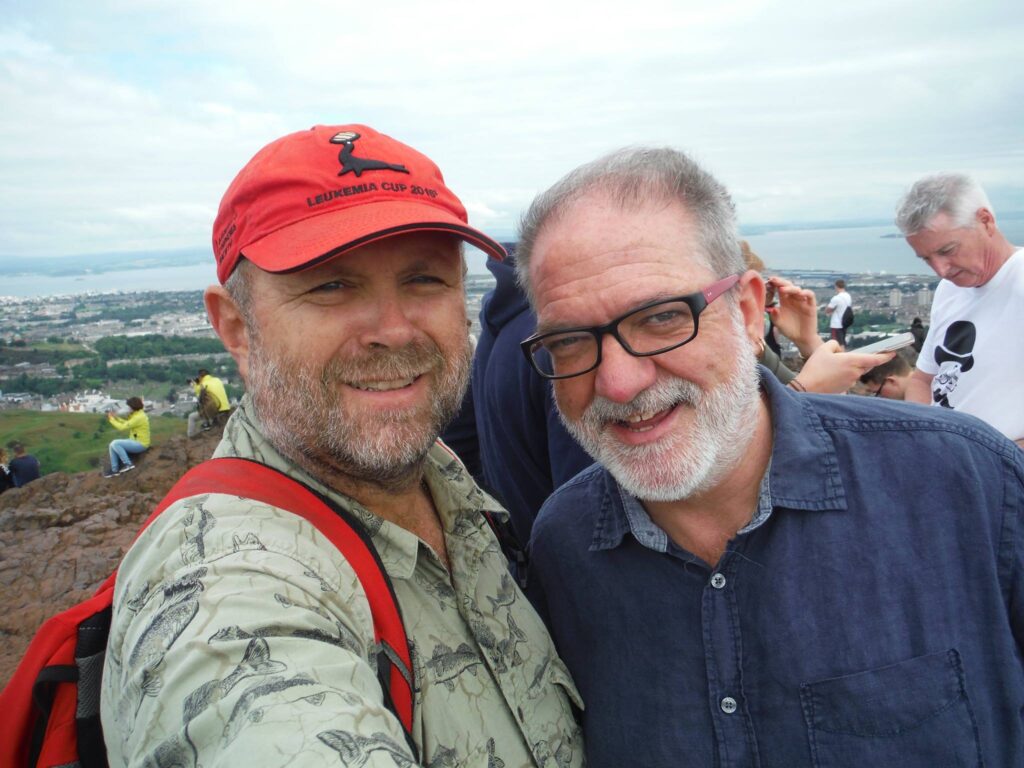
After a quick breakfast of porridge with Ewan, we head to the train station. I thank him for his hospitality and walk down the ramp to board the waiting 7:15 AM train for Glasgow. This is the first of my multiple leg journey to the Isle of Iona. Minutes later, the train rolls through the countryside, stopping every so often at a station where an automatize voice of a woman encourages folks to “Please mind the gap when alighting this train.” As it’s Saturday, the train has few passengers. The conductor stops and talks, telling me where the best to get coffee in the Glasgow Station (which he recommends over the coffee they serve on the train). I ask him where I can find a bank machine (they don’t call them ATMs over here) and we talk about the West Highland Line which I’ll be taking to Oban.
In Glasgow: banking troubles
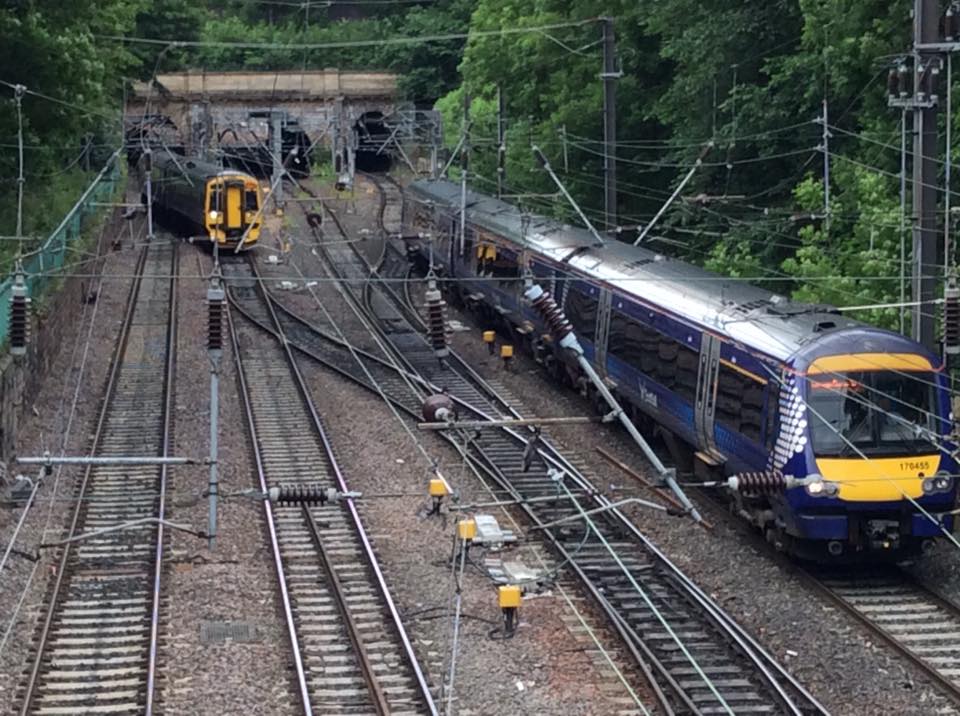
I only have fifteen minutes in Glasgow. I grab coffee and then head to the bank machine. My card is denied. I try again. It’s denied again. The call for the boarding the 8:21 train north. The next train is two hours later, and I don’t want to wait. I have some cash on me, maybe 50 pounds, but know that once I get to Iona, I will need cash. I’ve been told most places won’t take plastic and there are no bank machines. Thankfully, I’ve prepaid for the week. At least I will have a place to stay and can eat.
The train pulls out of Queen Street Station and soon we’re leaving the city behind as we race along the north bank of the Clyde River. I try to reach my bank by cell phone. This isn’t a local back, it’s a rather large regional Midwestern bank, but even their call center has “banker hours.” Its 3 AM back in Ohio. I hope to have time to get things straightened out during my short layover in Oban. I want to kick myself for not calling them before leaving the country, but I try to put the worry behind me. There is nothing I can do at this time. I look out the window. It’s rainy and gloomy.
Heading north
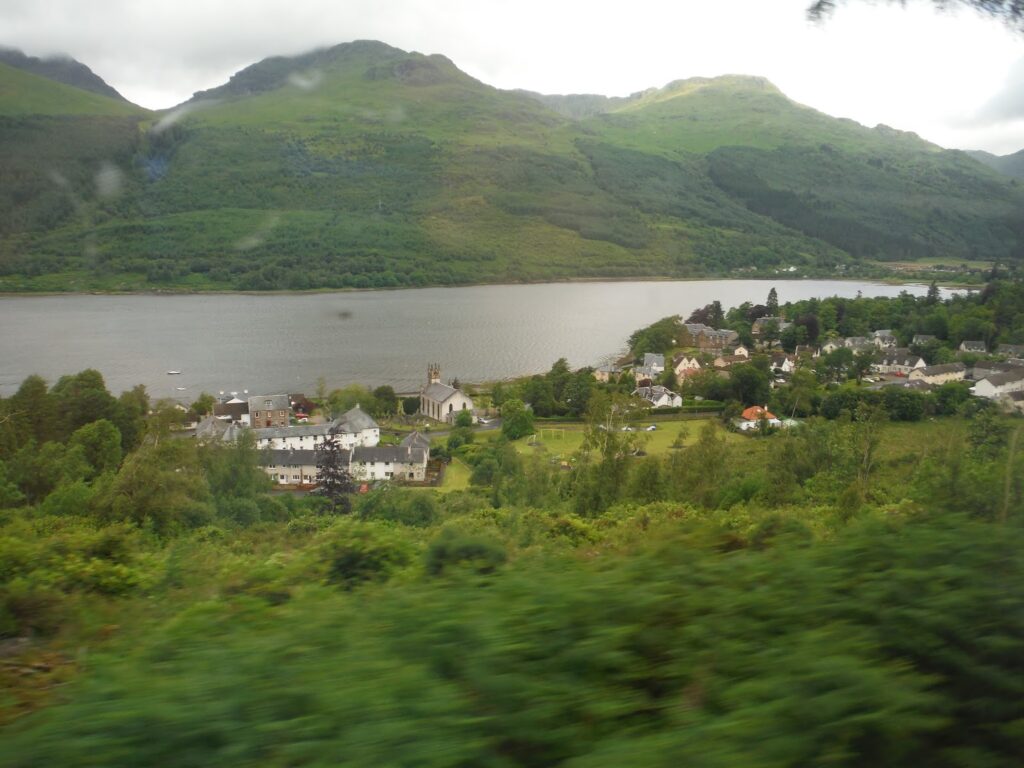
At Dulmuir, a group of young women board. They’re loud and keep jumping back and forth from seats. I offer to trade with the one of them who sits across the aisle with a couple from Glasgow, so they could all be together. Furthermore, I can be on the side of the train with the water. The train is now moving northwest, running alongside Gare Loch and Loch Long, both saltwater lochs open out into the Firth of Clyde. The couple tell me there’s a naval base along here for submarines.
Their son has spent his life at sea, mostly as an officer on merchant vessels. The woman tells me about his ship being at Newark, New Jersey on that fateful day in 2001. As it was mid-day in Scotland, he called to talk and was on the phone when the first plane crashed into the World Trade Center. He has since given up traveling the world and today is a captain of a buoy and lighthouse tender. His ship is in Oban for the day, so they’re taking the train up to have lunch with him.
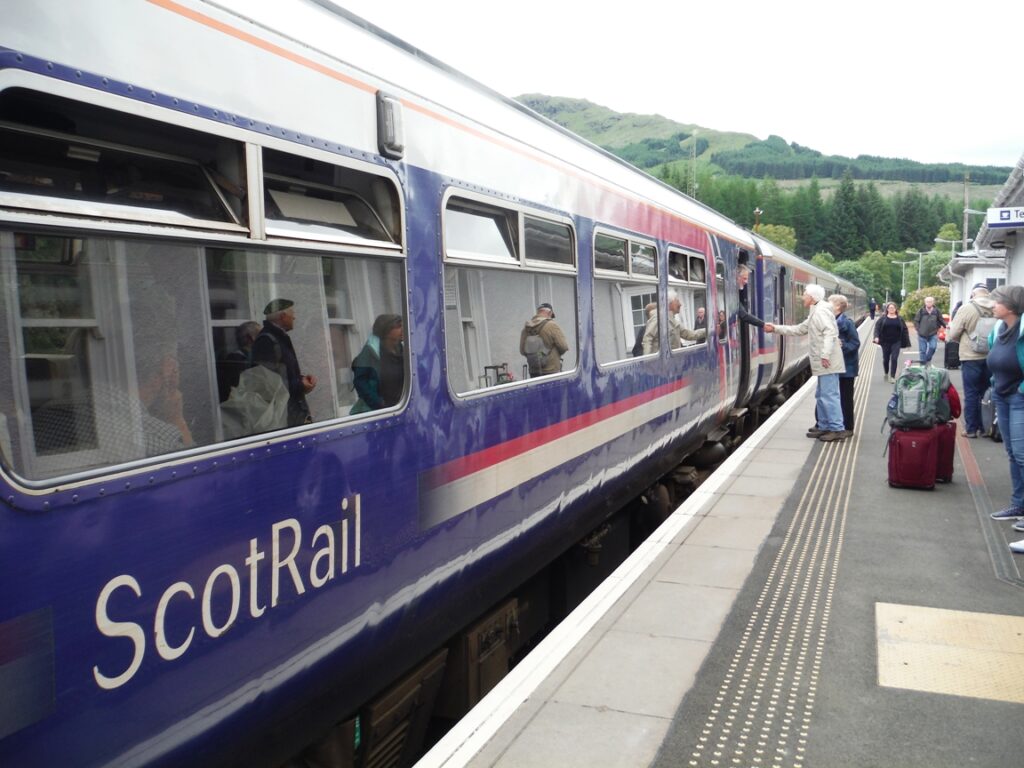
The train leaves Loch Long and passes over a short bit of land before coming into Talbert, on Lock Lomond, one of the more famous lochs in Scotland. We run alongside the loch for ten or so miles before climbing into the hills north of the loch.
At Crianlarich, which appears to be just a train station in the woods, the train splits. They had informed us in Glasgow to sit in the front two coaches. We’re now bound for Oban. The last four coaches head for Fort Williams and Mallaig (a line I plan to ride next Friday). After a few minutes, we’re riding through the woods. After Dalmally, we come alongside Loch Awe (what a wonderful name). In the middle of the lock are the ruins of a castle. We are heading west now, and soon pick up Loch Etive, which is open to the sea. I’ve recently read that the furthest you can get from the sea in Britain is sixty-five miles and looking how these saltwater lochs reach so far inland, I understand how that’s probably the case.
Still worrying about my bank card as we head into Oban
My worry over my bank card has bothered me all morning. Then it dawns on me that I have another bank card on me. While it’s a bank I don’t use as often, generally it is just to hold cash, it’s local and a few days before I left, I had made a deposit. Doing so, I told the teller of my plans for travel out of the country. She assured me she’d make a note on my account so I wouldn’t have a problem. I’m more than a little relieved as I’m not sure I’ll have time to contact the other bank when in Oban.
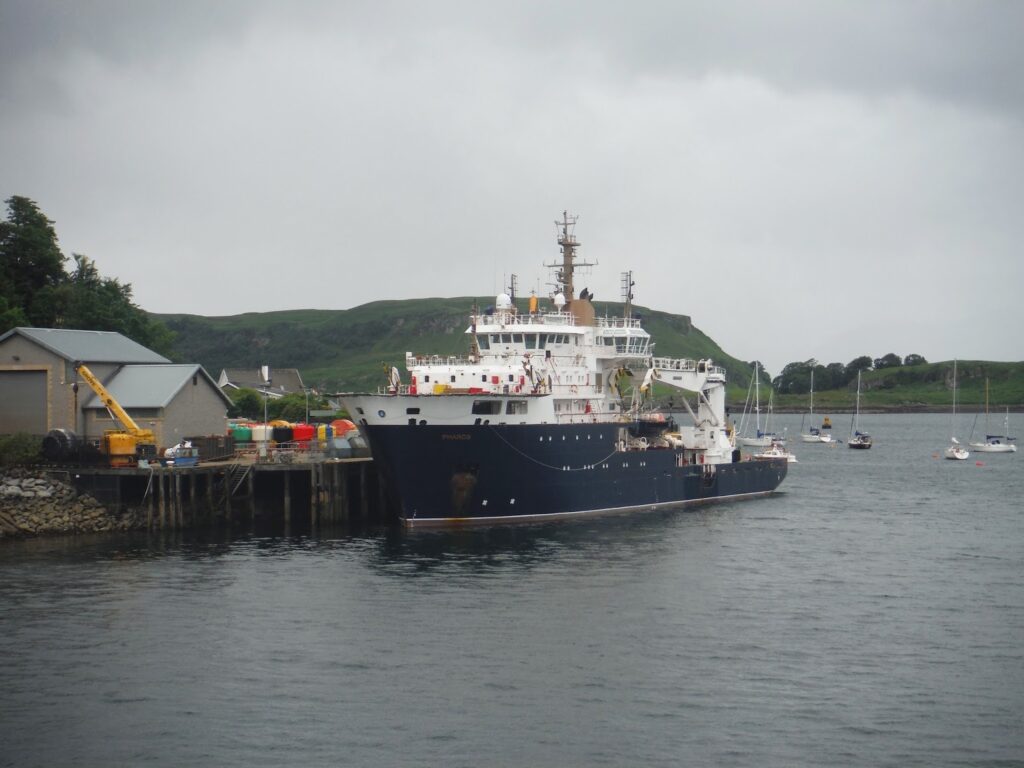
After Connel, the train turned south and we’re soon in Oban, an old town built around a harbor. It claims to be the seafood capital of the world. The couple point out their son’s ship, docked just behind the ferry terminal. I bid them farewell and wish them a wonderful lunch and walk out of the train station looking for a bank. It all falls in place. There’s a Bank of Scotland with an ATM just across the street from the train station. On the other side is the ferry terminal. I have nearly an hour before it leaves. I withdraw 200 pounds from the bank, then walk across the street and buy lunch from a vendor (a tuna and cucumber sandwich and an apple).
Ferry to Mull
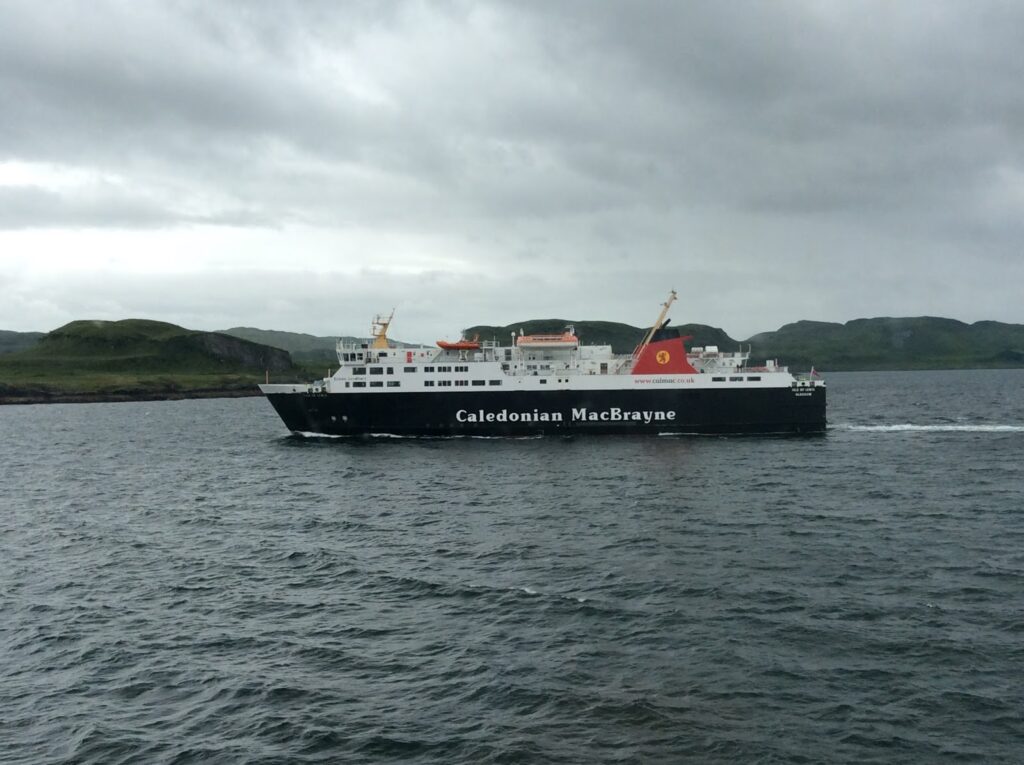
Taking the lunch with me, I board the ferry for a fifty-minute trip to Craignure on the Isle of Mull. With spendable cash in my wallet (my American dollars aren’t much good), I’m at ease. I find a place to sit on the upper deck. I’m sheltered from the weather, but am outside. I sit down and enjoy my sandwich as the boat pulls away from the port and makes its way through the harbor.
The harbor has several sailboats moored, as another makes its way into the safety behind the break wall as we push off from the pier. The day is stormy, and I wear a rain jacket. The entrance to the harbor is rather narrow. The ship slows to let a small passenger ship (or a large yacht) make its way into the safety of the harbor. As we go outside, the waters are rougher. I can’t imagine sailing in such waters in the small boat as had just made for the harbor.
Thoughts on Iona
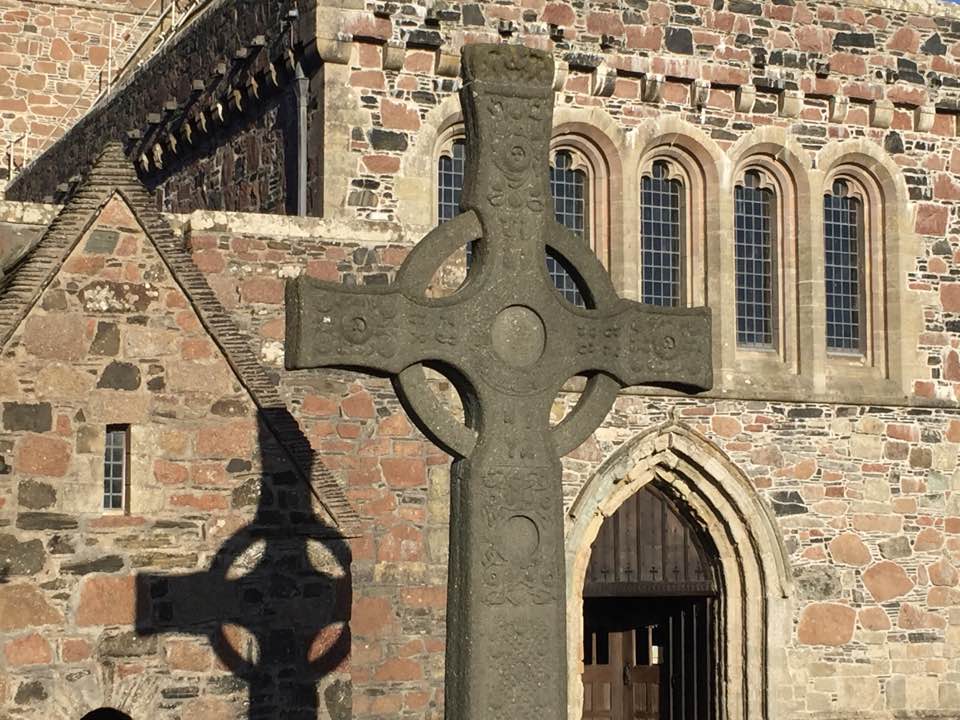
As we leave the mainland, I think about my destination. I’ve wanted to visit Iona for a long time and now can achieve this goal. Iona has been a destination for pilgrims and the curious for nearly 1500 years. In 563, an Irish abbot named Columba and a group of twelve disciples (sound familiar) land on Iona, where they set up a religious community. At this time, sea travel was easier than traveling overland on non-existent roads, and the small island becomes a center of faith and learning that extends throughout the British and Irish mainland and the islands that surrounded them. The Book of Kell’s was supposedly produced here, and some think the practice of carving large stone crosses which are prominent in Ireland and on some of the Scottish Islands, also began on Iona. The community thrived until the 10th Century when Viking raiders began to pillage the islands. Although a few monks continued to live on the island, the center of learning was moved to Ireland where it was safer from these raids.
In the 12th Century, after the Viking threat had waned, the island began a new period of importance as a Benedictine monastery was founded on the site of Columba’s monastery. About the same time, an Augustine nunnery was also founded on the island. These two continued until the Scottish Reformation in 1560. Afterwards, the site slowly began to crumble, but became a place for artists and authors to visit (a who’s who of British literature in the 18th and 19 century made journeys to Iona). Eventually, the site became property to the Duke of Argyll, who allowed it to be used as a place of worship for all denominations (Church of Scotland/Presbyterian, Roman Catholics, and the Scottish Episcopal Church). In the late 19th Century, he turned the site over to a Trust who worked to restore the ruins. In the 1930s, a new Iona Community emerged and continues to this day.
Crossing to the Isle of Mull
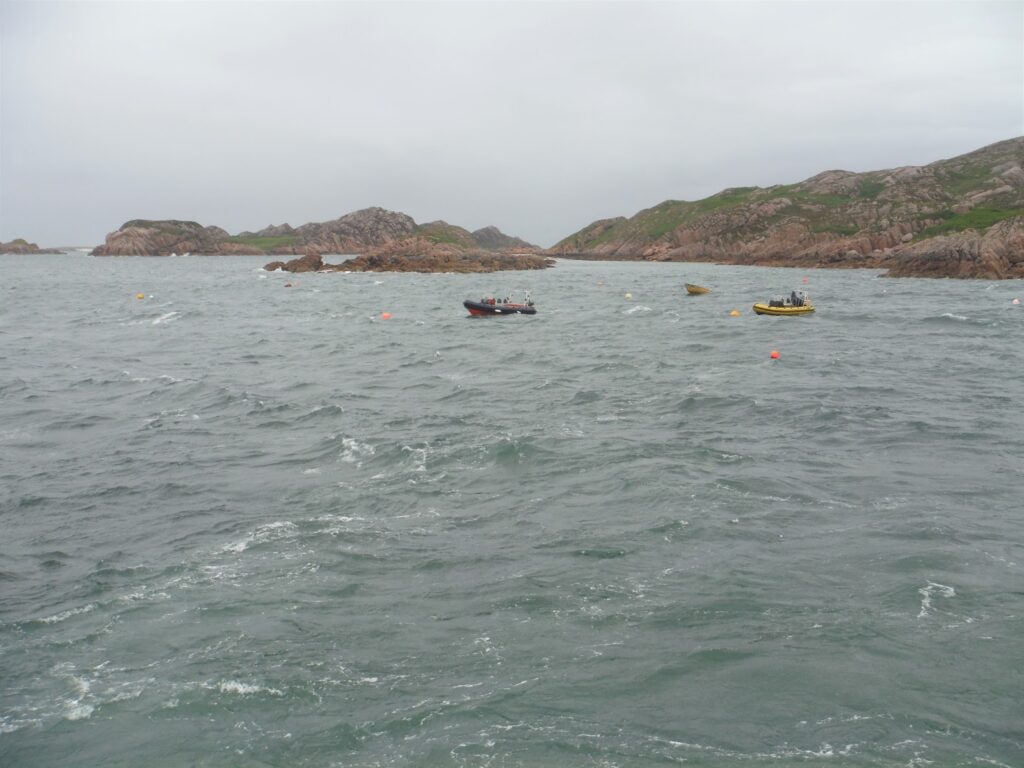
Approaching Mull, at Craignure, we pass the ruins of the Durant Castle. This country feels old. Soon, we pull up to the pier and those who have cars below are asked to go below and prepare to disembark. Along with maybe a hundred or so others, I disembark down the gangway to a line of buses. I find the bus for Iona and stow my backpack in the luggage compartment and pay the 15 pounds (round trip as I’ll be returning this way next Friday) and take a seat in the back.
It’s nearly fifty wet miles across Mull, mostly on one lane roads (with turnouts so that vehicles can pass one another). The bus runs across Glen More in the center of Mull, and then drops down to the Ross of Mull, where we run along Loch Scridain. The driver is a bit of a maniac, gunning the engine where there is nothing ahead and at times stomping on the brakes in time to pull into a passing place. It’s still raining but the countryside is beautiful, with lots of rocky hills, plenty of wildflowers, fields covered with ferns, and interesting varieties of cows and sheep. The distant hills and mountains are shrouded with fog. After nearly an hour, we pull into the small town of Fionnphort, where we unload.
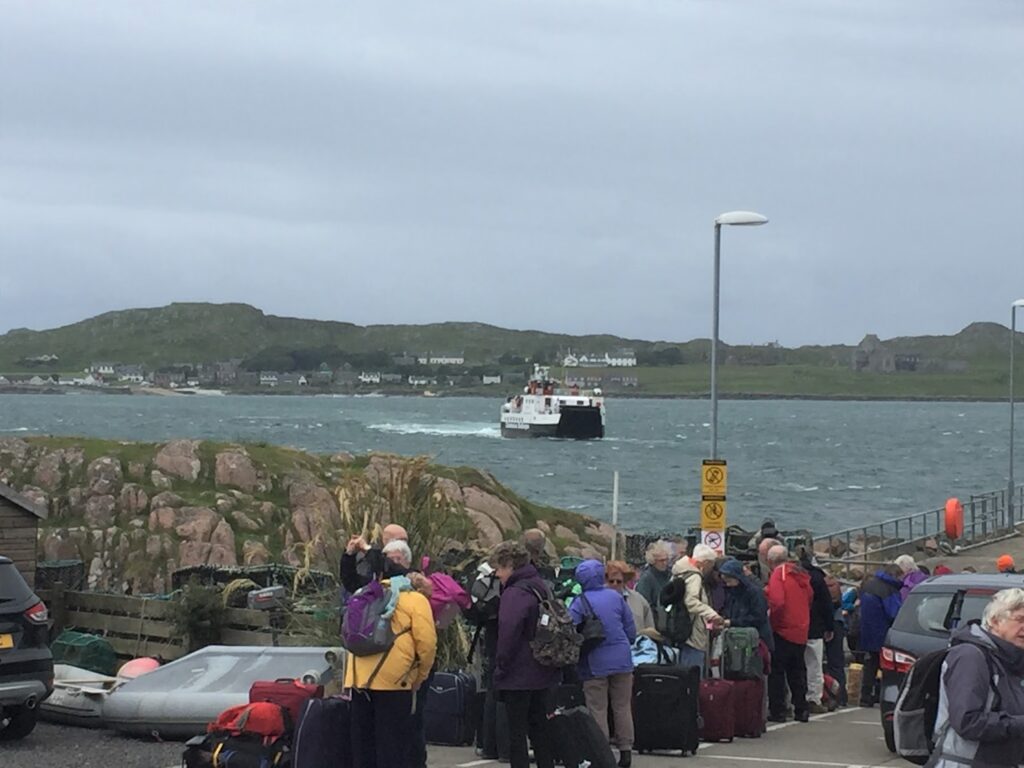
Everyone on the bus is headed to Iona, with most spending a week as a part of the Iona Community. I began to introduce myself to folks who have been on the same train and ferries going back to Glasgow. We all stand at the ferry terminal, with our packs and suitcases beside us, watching the ferry bounce around in the water as it makes its way across. Iona is easily seen in the distance. This ferry is a lot smaller than the other one. There are just two cars going across (a special permit is required to take an automobile to this island that’s only 5 miles long). Most of us are on foot. We board and I find a sheltered place up top, where I can watch the island approach.
On Iona

The Iona Abbey is easy to spot. Soon, I’m on the last leg of my journey, a fifteen-minute ride across the Sound of Iona, in which I gain my sea legs. The ferry pitches and rolls and struggles to dock against a strong wind and tide. Once we arrive, we time as we get off the ferry, so that we avoid splashing our feet in the water. There are vehicles waiting to take our luggage, while it’s up to us to walk the third of a mile to the Abbey and the MacLeod Center (I’m staying in the later).
At the McLeod Center, I find my bunk and unpack. It’s an hour before dinner, so I lay down and watch through the window the grass blow in the wet wind. I love the sound of the wind, and soon am napping to its calming presence.
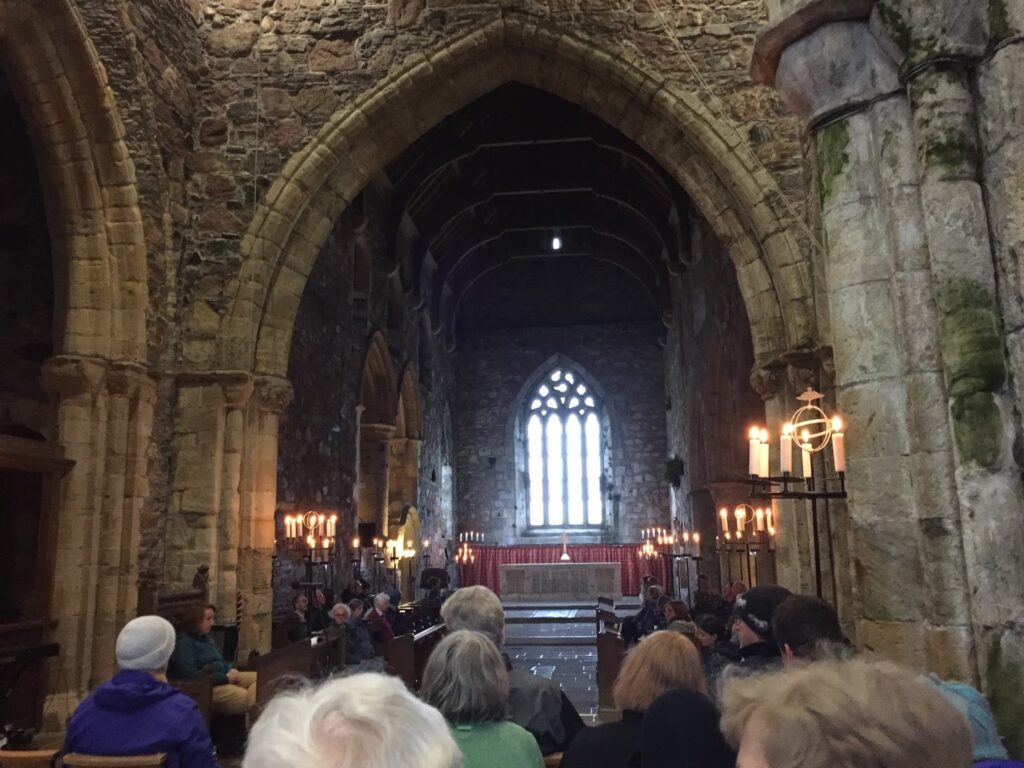
Dinner is simple but delicious: carrot and turnip soup, good chewy bread, raw vegetables, fruit, and desert with coffee. Afterwards, we spend a few minutes getting to know everyone, learning our duties for the week (I’m to help at breakfast and will chop vegetables for the lunch and evening meals). At 7:30 PM, we walk in the rain down to the Abbey for the welcoming worship service. Lighted with candles, the sanctuary is beautiful. It’s still light after the service. This far north it will be for several more hours. I’ve been up a long time. Tired, I go to bed early.
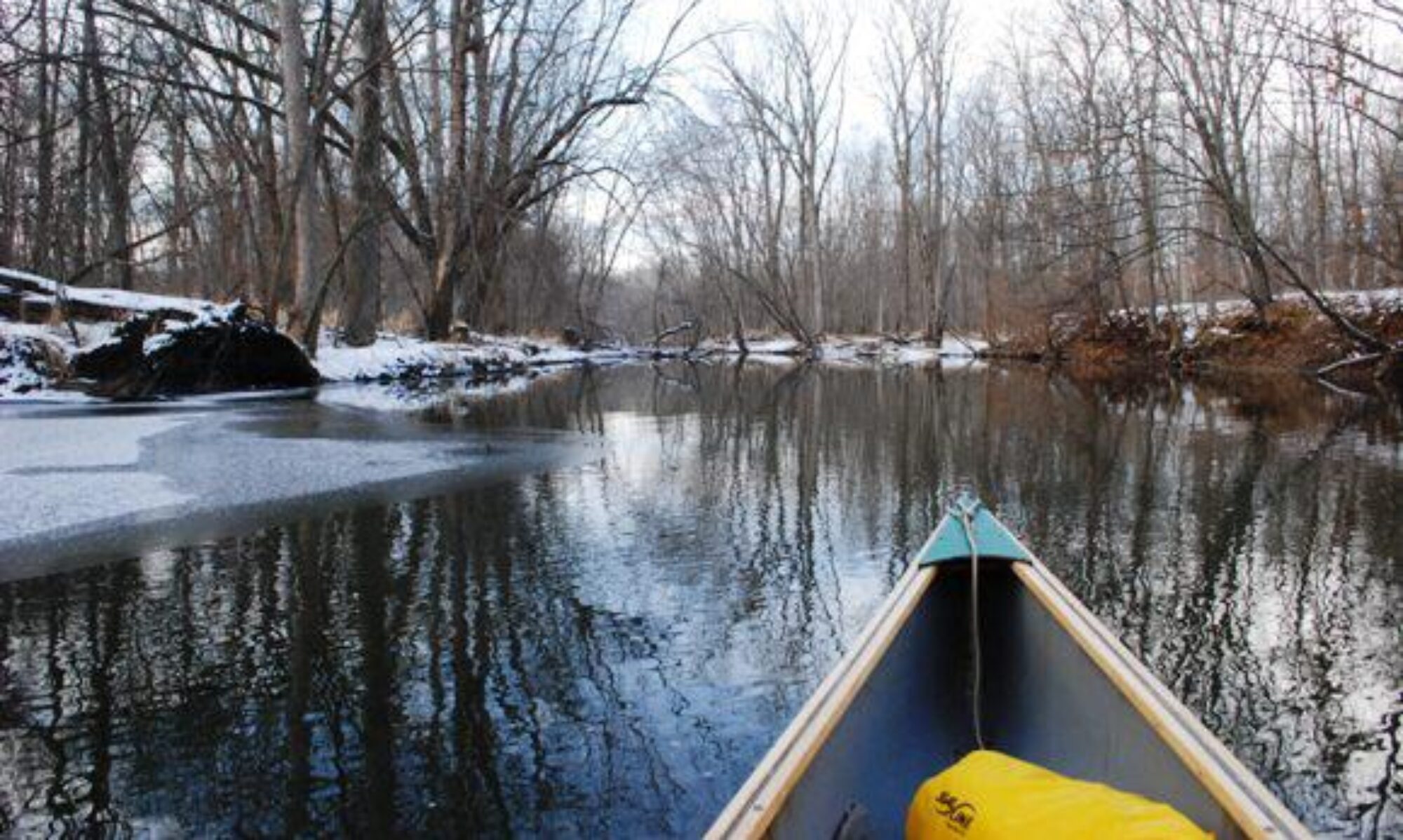
Hi Jeff – yes I remember your post about Iona and your visit there. I never been to the Scottish islands – one day I might get there. Go well and have a blessed year ahead. Cheers Hilary
Thanks, Hilary. And I hope you get up to the island!
This is great and very timely. The wife and I are headed to Scotland in early September. As usual, she has planned the itinerary so I’m
not sure of all the places we’ll be going, but I recognize some of these names from hearing her make the plans. I’m looking forward to it.
Bob, Scotland is a wonderful country and if you’re traveling on your own, the rail pass is a good deal as it covers the trains and many of the ferries. If you have any questions, let me know.
I really like reading about your travels. I don’t like traveling myself but I like reading about others doing it and seeing their pictures.
Thanks, traveling is fun and I am so ready for the pandemic to really be over!
Lovely post! I visited Iona for a week as a student and more recently attended a wedding on the island. The journey there is amazing and the island is beautiful.
I hope to get back to Iona again. I hear they do a wonderful Christmas week and have considered trying it when I retire.
Thanks Jeff. My sister and I spent a day there in May 1988. We took the last ferry there and either had to go back or stay the night. We found a place and joined the Abbey community that night. Remember meeting an AA group from Glasgow. I also walked the island and found golf flagsticks. Don’t remember what we did with the rental car. I think we were on foot.
You probably left it in the parking lot at the ferry terminal. I know those who came to the Abbey and drove did that. I don’t ever plan to play golf again, but if I did it’d be on Iona. I liked the idea of playing through cows and sheep. If your ball landed on a cow paddy…
I remember when you went on this trip!
We loved our family trip to Scotland in 2018 – just a few days in Edinburgh and we felt we’d just scratched the surface. I think a return trip is likely someday.
You travel with meaning. I always enjoy your reports.
Scotland is a neat place. I want to get out into the Outer Hebrides and the Orkies and Shetland Islands one day.
I think I remember your earlier post about this. I have a friend who’s been there and I would love to visit!
You should go! And I want to go back.
I would love to go on that kind of trip.
You should. A lot of people from the states travel there.
What a great memory, Jeff. I worried with you about the ATM, marveled at all the legs to the journey–and you did all flawlessly alone, enjoyed the sights, became wrapped up in your view. Thanks for taking me along.
I was kind of worried about that, too! I wasn’t too worried of it in Iona, but I did want some cash before I continued my travels on to Skye and the Inverness and up to Wick. But all those places I had plenty of ATMs and had gotten my main card approved once they realized I was out of the country.